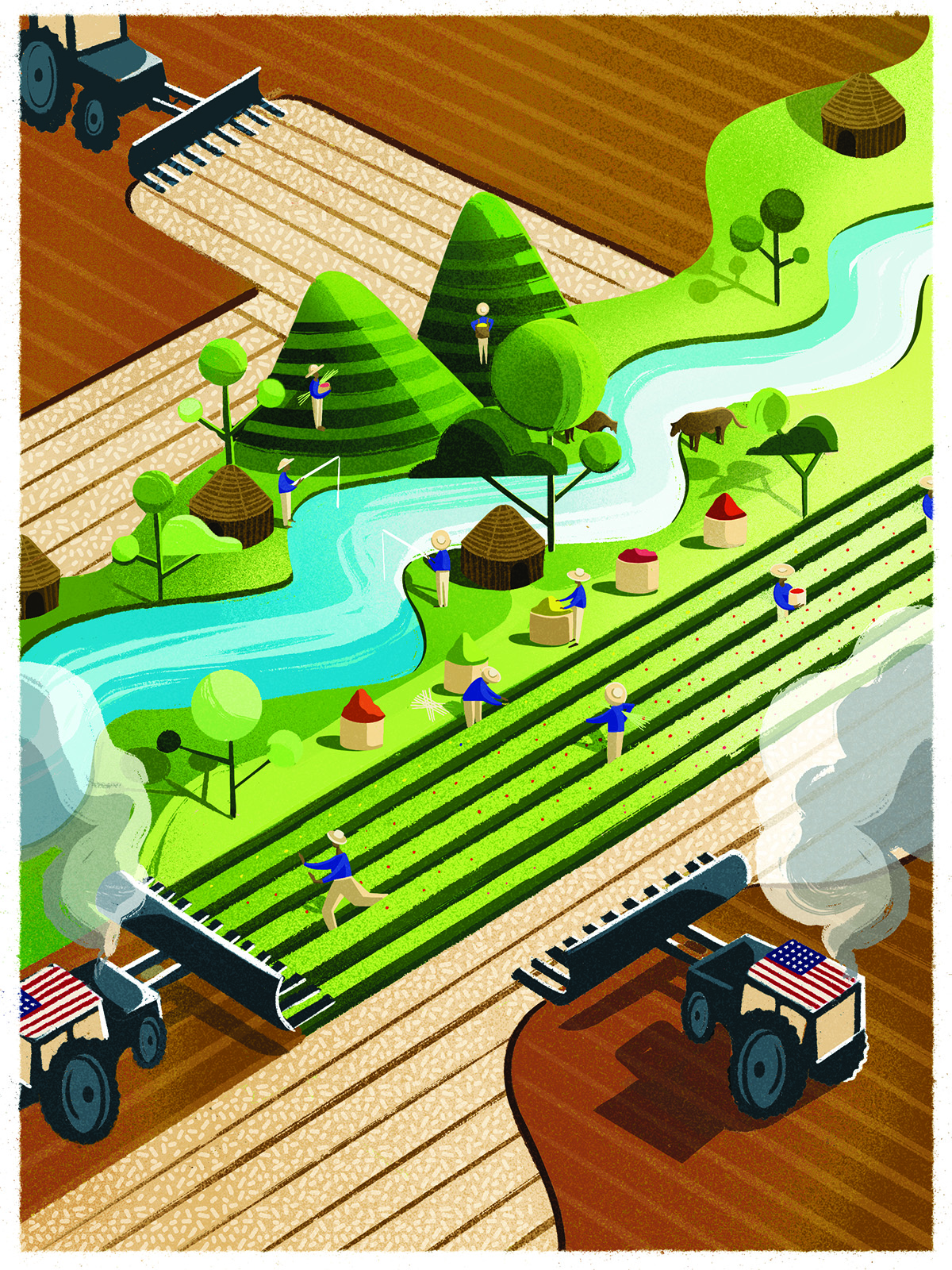Contributions of Peasant Farmer Communities: The Case of Venezuela
By Miguel Ángel Núñez
Volume 25, no. 1, The Soil and the Worker
This article is originally published in Spanish. Lee este artículo aquí.

Throughout their history, agricultural, chemical and food corporations have created and implemented tactics to marginalize the peasant farmer community and indigenous people. Done in complicity with regional governments at various levels, these people have been displaced from their original lands and subjected to wars and terrorist actions promoted by oligarchies. Transnational corporations and governmental corruption are only some of the forces that stand in the way of the social and political stability of our peasant farmers.
Despite these existing conditions and the difficulties and the risks entailed, peasant farmer communities continue to produce the majority of the world’s food. Let’s consider the case in Venezuela, a country living through hundreds of sanctions and unilateral coercive measures generating an economic and financial blockade in an attempt to strangle the Venezuelan people—who have responded with a significant food production.
Peasant Farmers at the Global Level
At the global level, peasant farmers produce approximately between 55 percent and 75 percent of the world’s basic foods.1 Another updated report confirms that peasant farmers—not food corporations—are the ones that feed the world. Seventy percent of the world population is fed by means of the farm food network.2 Moreover, in comparison to corporate agriculture, they use only 25 percent of water and energy resources.
These basic production numbers from our peasant farmer communities are a reflection of a socio-productive space where agroecological production thrives and progresses. Note that at least 75 percent of the 1.5 billion farmers and indigenous persons cultivate their foods without agro-chemicals.3
Progressively, agroecology is establishing itself as an emerging agricultural science that presents us with concrete technical options to curb the onslaught caused by climate change and the COVID-19 pandemic, itself a consequence of the eco-social world crisis. In the face of the current extreme conditions of the global eco-health crisis, agoecology is the only productively viable scientific option. It offers us two vital outcomes: the capacity to feed ourselves daily, and the maintenance of optimal health, two processes that cannot be interrupted in our daily lives.
On a global level, agoecology has been positioned in universities and research institutes as an important tool. Some of the organizations that recognize the validity of these scientific claims are IPES-Food (International Panel on Sustainable Food Systems), IFOAM (Organics International), and Agroecology in Europe.4 Just as these institutions have expressed it, we should center food and agricultural politics in agroecology as the primary strategy to achieve autonomy and resilience, a strategy that can quickly transform the ways in which we produce and consume food, and at the same time address global challenges—including climate change.5
From our understanding, agroecological science is a matrix that unifies all wisdoms: that of original farming communities, indigenous people, family famers, and people of African descent. It is born out of collective community wisdom and it strengthens different scientific agricultural trends with knowledge from peasant farming science.
Knowing Through Science
It’s evident by reflecting on the various modalities in the different farming landscapes used by our peasant farming communities that multiple functions, strategies, and farming practices are employed. These generate a set of knowledge and wisdom for us that we should take into account. Such learnings point to solutions for specific production problems, the diversity of food that is produced among associated crops and their nutritional and gastronomic needs. All of these actions, which we still find in peasant farming life, are a wealth of knowledge, knowledge combining diverse learnings that emerge from communal, social, cultural, and collective wisdom.
This, in part, is what the knowledge of what occurs in the day-to-day activities of our peasant farming communities addresses. From there emerges what has always been known as empirical knowledge, meaning knowledge based on experience and facts. This is common wisdom that has been socially transmitted.
It hasn’t been possible for an evolution of our original agriculture to exist without a relationship of the social to the ecological, and of the ecological to the social.
Therefore, we understand this knowledge through science from our peasant farmer communities to be processes of permanent knowledge creation which are interpreted in their own particular ways and through the use of a theoretical imagination integrated with praxis. It is a type of common wisdom where the traditional ways in which human beings have lived (and have been sustained for centuries) interplay with suitable adaptations from technological innovations. This in turn recreates their vital systems and integrates them into the different values of our intercultural reality. This peasant knowledge through science emerges as a reply to the demands of territorial, community and local production. This strengthens cultural and community values by accomplishing many of life’s necessities and filling them with a spiritual transcendence that comes from peasant farming communities.
Agro-food and Agro-biodiversity
This knowing through science from our peasant farmer communities expresses itself through hundreds of agricultural practices. These practices have been sustained at the foundations of our societies and by these farmers’ interactions with their particular environments. It hasn’t been possible for an evolution of our original agriculture to exist without a relationship of the social to the ecological, and of the ecological to the social. Traditional agricultural practices feed, and are fed from, different cultural practices. The diversity of different cultural manifestations (be they religious, related to dance, artisanal) constitutes the highest ideological and cultural expression of our peoples. Latin American cultural diversity has been legitimized through the diversity of original agricultural practices that we still have in our regions and that we still find in our associated crops or polycultures.
In Mexican and Central American agriculture, there are farms called “chinampas” and “milpas.” In the Andes, there are farms called “chacras.” In the tropical Caribbean, there are parcels of land called “konucos” in marshes, along waterways lined with moriche palms, in meadows, along beaches, and on savannas. In the Amazon areas that are home to many indigenous ethnicities, we still find types of agriculture such as swidden, migratory, intensive, and subsistence.
Among these modalities, the expressions and related arrangements of crops stand out. This bears witness to the agricultural diversity and to the agricultural practices of our peasant farmer communities, practices which adapt themselves to natural resources and specific agro-ecosystems.
| Chinampas: Small plots of land with a structure or overlay made from stone, reeds or bamboo (and some made of dirt) where vegetables and flowers are cultivated. Originating from Aztec and Mayan cultures.
Milpas: Meso-American and Central American ago-ecosystem from Mayan, Aztec, Toltec and other cultures that is distinguished by mixing corn, squash, beans and pepper crops using a progressive integration with other permanent and semi-permanent crops such as tubers, leafy vegetables, fruits and medicinal or aromatic plants. Originating from the Quechua culture. Chacras: Farms or plots (with ploughs and suitable irrigation systems) based on intensive mixing of crops or polycultures of corn, quinoa, beans, bell peppers, diverse types of tubers, leafy vegetables, fruits and medicinal or aromatic plants. Originating from the Quechua culture. Konucos: Family farming plots (found in the Caribbean, the Andes, savannas and the Amazon) where the land is prepared through use and management of eco-technologies, planting related crops or polycultures. Planted crops are led by corn, beans and squash depending on climatological conditions. |
Peasant Farmers and Agro-Biodiversity in Venezuela
In Venezuela we’ve recorded 462 plants and agro-food species (including aromatic plants, cereals, coloring agents, condiments, tree bark, spices, stimulants, fruits, leafy vegetables, legumes, seeds, roots, and tubers). These provide the country with great biodiversity and the second greatest in Latin America after Colombia.6 This is a geopolitical situation, which confers on Venezuela a variety of soils, favoring the production of different agricultural products during different seasons.
Among our mountain ranges at different latitudes we find platforms, terrace practices, and ground terracing in our Andean konuco farms. Likewise, konuco farms are found in hillsides, at the bottom of valleys, in flatlands with agricultural activities in flood zones, places with the characteristics of extensive savannas, grasslands, plains, and jungles. There we perceive the practices of agroforestry and agriculture mixed with cattle ranching and extensive fruit orchards. In all of these modalities diverse practices have been used, such as cover crops, green fertilizers, crop association or polyculture, crop rotation, water reaping practices, land conservation, and other common and suitable technologies.
These many practices are connected to diverse forms of irrigating and working the land, with or without the use of animals, in ways such as the optimal use of land slopes, taking advantage of special territorial conditions (like microclimates and the best distribution of water), seed genetic improvement and adaptability, the most suitable crop association and arrangement, use of the moon phases, know-how concerning patterns of precipitation, use of plants to cure other plants, and the biological mutualism between roots. All of this knowledge has solid scientific foundations. However, it has been underestimated by academia and related institutions. The knowledge hasn’t been valued enough.
The historic scientist-peasant farmer alliance is oriented towards and promotes knowing with science as a response to the demands of territorial agricultural production, communal and local.
These agricultural teachings and practices deserve to be duly recognized, since they have strengthened many forms of knowledge – chief among them polyculture management and crop association. These encompass areas of agroecology like land recovery, holistic integrated management of crop infestations and diseases, seed selection and planting, and different processes of resilience against climate change, among others. All of this integrated knowledge is invigorated through different arrangements of crop association which demonstrate for us the various points of nexus and existing relationships between the different biological, chemical, and physical phenomena and entities. These serve as a foundation so that both types of knowing (empirical and scientific) are integrated and can blaze a new trail in national food science.
Our millions of peasants farmers continue doing agriculture in different modalities and styles without the use of agrochemicals because they have been applying ago-ecological principles and strategies. We must know how to address this, to systematize their practices and see them applied in our areas of work. There we will find various forms of wisdom and knowledge, that all manner of scientific considerations have provided us. These scientific considerations strengthen and connect the knowledge of agriculturalists with food science; demonstrating for us just, opportune and valuable contributions for agriculture and productive processes.
Knowing with Science in Venezuela
The Venezuela Ministry for Science and Technology promotes the alliance between the formal scientific world and peasant farming communities. Minister Gabriela Jiménez has presented a proposal to “communalize” science. This means bringing formal science directly to communities and community organizations.7
Minister Jimenez is promoting a scientific-farming alliance, which accelerates and develops initiatives and practices that will improve not only agricultural production but also methods of production for seeds and various crops. The chief idea of this alliance is that formal and informal production processes can feed into one another and also begin to learn from each other.
Presently more than 3,500 families (as part of 124 nuclei), belong to the scientific-farming alliance in Venezuela. They are located in thirteen of the twenty-four Venezuelan states. Until now they have achieved substantial advances in seed production from these crops, in the application of agroecological principles and in attaining basic food self-sufficiency in neighboring populations.
The historic scientist-peasant farmer alliance is oriented towards and promotes knowing with science as a response to the demands of territorial agricultural production, communal and local. In addition to the main demand of transferring technology and facilitating the exchange of seeds between konuqueros and communities, the alliance proposes transitioning to national agroecological production. Towards that end, there is a process of monitoring and active participation in various strategic actions connected to the impetus from the Plan Konuco and from agroecology, from the Great Agricultural Mission of Venezuela.8 In elaborating these considerations, researchers from the Venezuelan Observatory of Popular Economies refer us to various research projects in thirteen states, benefiting 287,241 families, who have succeeded in producing 189,866 tons of food. 9 By the end of 2019, the All Hands to the Sowing Program in 22 Venezuelan states had succeeded in organizing 14,403 scholastic konucos, among 1,359 educational institutions and training 86,964 people.
Now, with dignity and respect, our peasants are helping us to transition to a new agriculture, promoting a paradigm shift away from imposed agricultural knowledge, as part of the process of decolonization.
On the other hand, Venezuela relies on more than 100,000 hectares of land cultivated using agroecological methods.10 Much of this land derives from the experiences of urban and family-run konucos. Another significant Venezuelan experience worth mentioning is that of the organization People to People, which for six years running has provided 170 families with 3,500 tons of healthy, fresh food at below-market prices.11
Conclusions
It’s no secret that our beloved Venezuela in the last six years has been confronted with a complex situation, a hybrid, non-conventional proxy war with terrorist attacks and aggression of all sorts, where we have been subjected to coercive methods and international financial blockades (including by private companies), all of which has contributed to a destabilization of the economy. To this we should add the separate forms of precarity that the COVID-19 pandemic has brought us. Given all of this, what we can argue is that the Venezuelan people have demonstrated to the world their capacity to resist in defense of national sovereignty and their dignified way of persisting and advancing on different socio-productive fronts.
One of our most important sectors is the primary production of foodstuffs, which has not stopped during the pandemic. We reaffirm that more than 75 percent of the foodstuffs produced in Venezuela are consumed by Venezuelans, which represents an extraordinary advantage because it means that during the severe conditions of the hybrid war that we find ourselves in, food production not only continues but also keeps advancing and improving. These conditions of peasant food production are viewed as natural, sufficient, and fundamental, strategically as part of the war of resistance and of confronting the various contingencies.
Everything expressed so far indicates to us that our national peasant agriculture sector, in addition to providing the food making up the basic national diet, provides us with a whole array of learnings within the knowing through science that we have described earlier.
Our scientific awareness helps, encourages, and teaches us to free ourselves from the aftermath of the colonial agricultural mentality—ideological, political, and scientific—that they want to impose on us. Now, with dignity and respect, our peasants are helping us to transition to a new agriculture, promoting a paradigm shift away from imposed agricultural knowledge, as part of the process of decolonization that we are facing.
We have reached the moment of beginning to recognize, reassess, re-value and validate the many contributions that our peasants have continued to offer the world, toward the construction of another possible civilization.
—
Miguel Ángel Núñez is a Venezuelan agroecologist, writer, teacher, and researcher. He was an advisor to the Office of President Hugo Chavéz in 2004–2007, and currently advices for Venezuela’s Ministry of Science and Technology. @17MiguelAngel | @Ecoagro2020
Notes
- “¿Quién nos alimentará? – Preguntas sobre la crisis climática y alimentaria, 2009,” Grupo ETC, November 16, 2009, https://www.etcgroup.org/es/content/%C2%BFqui%C3%A9n-nos-alimentar%C3%A1.
- “Who Will Feed Us?,” ETC Group, October 15, 2017, https://etcgroup.org/whowillfeedus.
- “¿Quién nos alimentará?”
- See “Agroecology Definitions,” Agroecology Info Pool, accessed April 25, 2022, https://www.agroecology-pool.org/agroecology/definitions/.
- Miguel A. Altieri and Clara Nicholls, “Agroecology: Challenges and Opportunities for Farming in the Anthropocene,” International Journal of Agriculture and Natural Resources 47, no. 3 (December 29, 2020): 204–15.
- Hernán Cano, “‘Pueblo a Pueblo’: el plan popular para combatir la falta de alimentos en Venezuela,” Sputnik Mundo, 2021, https://mundo.sputniknews.com/20210811/pueblo-a-pueblo-el-plan-popular-para-combatir-la-falta-de-alimentos-en-venezuela-1114995100.html.
- “Ministra de Ciencia: Promover el conocimiento materno es una forma de construir paz,” Gobierno Bolivariano de Venezuela, Ministerio del Poder Popular para Ciencia y Tecnología, 18 marzo, 2022, https://www.mincyt.gob.ve/tag/alianza-cientifico-campesina/.
- Gobierno Bolivariano de Venezuela, Gran Misión AgroVenezuela (Caracas, Septiembre 2020), https://www.vtv.gob.ve/wp-content/uploads/2020/09/RESUMENEJECUTIVO-1-1.pdf.
- Consulta personal al Dr. Mario Sanoja, Caracas, Venezuela.
- “ONCTI – Noticias,” accessed April 26, 2022, http://www.oncti.gob.ve/noticiaONCTI79.html.
- Cano, “‘Pueblo a Pueblo’”.





